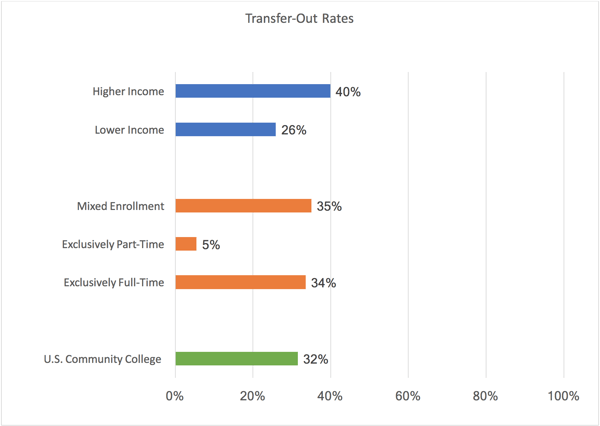Published on
We Need to Improve the Transfer Experience

There is a clear need to improve the experience for students who transfer. This was recently underlined by a report from the General Accounting Office (GAO), which details the ways students lose credit when they transfer and calculates the substantial cost to the federal government and to the student when this happens.
“Students lost an estimated 43 percent of college credits when they transferred, or an estimated 13 credits, on average … the average credits lost during transfer is equivalent to about four courses, which is almost one semester of full-time enrollment.”
This is completely unacceptable!
Community College Students Fare Poorly in Transfer to Four-Year Institutions
In a report from the National Student Clearinghouse Research Center we learn more about what happens to community college students when they transfer. This data uses the 2010 cohort of community college students for the analysis.
Less than 14 percent of community college students go on to complete a bachelor’s degree in six years:
“The overall rate of 13.3 percent shows in stark relief the fact that few students who start in a community college are able to earn their bachelor’s degree within six years.”
This may be due in small part to the fact that this 2010 cohort had a large percentage of students who were age 24 and above (24 percent) in the wake of the 2008-09 recession. The transfer-out rates for students who enrolled exclusively part time were very low. In the chart below, those enrolled exclusively part time at the community college had only a 5.4 percent rate of transferring.
Low-Income Students Fare Especially Poorly
Students from all income groups go to community colleges. However, the community college students who transfer to four-year institutions and come from higher income groups tend to complete at a higher level.
Students attending community colleges serving communities with lower socio-economic status (SES) were less likely to transfer to a four-year institution than students attending higher SES-serving community colleges (26.3 percent and 34.6 percent, respectively).
Additionally, after transferring, students who transferred from higher-SES schools had a bachelor’s completion rate 9.0 percent higher than that of students who transferred from lower-SES schools (44.7 percent and 35.8 percent, respectively).
While there was a relatively small difference in the transfer-with-award rate, there was a substantial difference in the transfer-out bachelor’s completion rate. This may indicate that the effects of socioeconomic differences tend to grow as students progress along their academic career.
Occupational Schools Fare Better
Surprisingly, students from occupational two-year colleges fare better than those who are on a primarily academic track in the transfer process.
Students from primarily occupational community colleges had higher transfer-with-award rates (35.8 percent versus 32.0 percent) and transfer-out bachelor’s completion rates than students from primarily academic two-year institutions (43.8 percent and 40.9 percent, respectively).
Overall, although students from both types of institutions have relatively similar transfer-out rates, differences emerge when degree completion is taken into consideration. Normally one would expect that a curriculum built around transferring (the academic focus) would do better in the four-year completion rate. However, students coming from occupational programs, which often have a better completion rate at the two-year institutions, fare better in transferring to and completing their studies at four-year institutions.
What Does All This Mean in Practice?
At Loyola University Chicago, we want to encourage academic accomplishments and help students complete their degree faster. That’s why the School of Continuing and Professional Studies (SCPS) is transfer friendly.
Most of our students have not completed the Associate of Arts or AAS. The average of transfer credits is 45 and many students present two to three transcripts at entry. At SCPS, we look at each person transferring to try to determine how to gain the most for the student. We have transfer agreements with many community colleges, helping students with a smooth transition to Loyola. In general, if a community college offers a course, we will accept it (unless the course in question is remedial or developmental).
Got a technical course? Even if we don’t have a place for it in the degree plan, we will take those courses to meet general elective requirements. Got a lot of credits in a program you’ve decided not to pursue? We’ll take those and apply them to an individualized concentration in our Applied Studies major. Completed an Associate of Applied Science? We’ll take that and give the student the best fit for our degree programs. We follow the Illinois General Education Curriculum (IGEC), enabling students to use either of our Loyola CORE or the IGEC to complete general education requirements. Flexibility is the key when working with transfer students.
This flexibility has not come easily. When we began this journey, the number of credits not accepted in transfer were large. Students were graduating with 130-135 credits and making poor use of transfer credits. Most of the technical courses from community colleges were not accepted for transfer. This stance was mostly dictated by the work of the university’s College of Arts and Science, which takes a traditional view of transfer courses. The core issue is that the university specifies the content of the major and the general education program. All else is elective. Using those electives to help transfer students is key to this transfer-friendly strategy. Charting a different path meant that the staff in our Registration and Records Office would need to be persuaded to accept courses for SCPS that may not be accepted elsewhere. Staff in admissions and advising would need to review transfer evaluations to make sure that we do not reject possible transfer courses and suggest the best path to the degree. Broader use of the transfer-friendly IGEC enables us to evaluate courses toward those requirements, giving us additional flexibility than the approach of the College of Arts and Science.
For working adults, completion of the bachelor’s degree is what matters. For our SCPS students, completion of the degree results in a doubling of their annual compensation within 3 years. The specifics of the major matter less to working adults (with their already existing base of work experience) than they do to traditional students. Getting to the degree completion goal is what matters.
We work to ensure that students do not lose credits when they transfer. A student deterred by transfer policy can waste credits, money, and time. Most importantly, losing credits when transferring inhibits degree completion—and our country needs students to be earning degrees at a greater rate.
Author Perspective: Administrator




